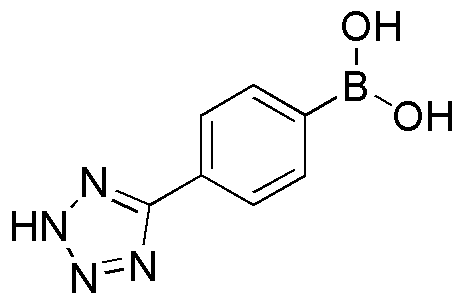4-(2H-Tetrazol-5-yl)phenylboronic acid is widely utilized in research focused on:
- Drug Development: This compound plays a crucial role in the synthesis of boronic acid-based pharmaceuticals, particularly in developing treatments for cancer and diabetes due to its ability to form stable complexes with biomolecules.
- Organic Synthesis: It serves as a valuable building block in organic chemistry, facilitating the creation of complex molecules through Suzuki coupling reactions, which are essential in producing various organic compounds.
- Material Science: The compound is used in developing advanced materials, such as sensors and polymers, where its unique properties can enhance performance and functionality.
- Bioconjugation: Its ability to selectively bind to carbohydrates makes it useful in bioconjugation processes, aiding in the development of targeted drug delivery systems and diagnostic tools.
- Analytical Chemistry: This chemical is employed in analytical methods for detecting and quantifying biomolecules, providing researchers with reliable tools for studying biological systems.
General Information
Properties
Safety and Regulations
Applications
4-(2H-Tetrazol-5-yl)phenylboronic acid is widely utilized in research focused on:
- Drug Development: This compound plays a crucial role in the synthesis of boronic acid-based pharmaceuticals, particularly in developing treatments for cancer and diabetes due to its ability to form stable complexes with biomolecules.
- Organic Synthesis: It serves as a valuable building block in organic chemistry, facilitating the creation of complex molecules through Suzuki coupling reactions, which are essential in producing various organic compounds.
- Material Science: The compound is used in developing advanced materials, such as sensors and polymers, where its unique properties can enhance performance and functionality.
- Bioconjugation: Its ability to selectively bind to carbohydrates makes it useful in bioconjugation processes, aiding in the development of targeted drug delivery systems and diagnostic tools.
- Analytical Chemistry: This chemical is employed in analytical methods for detecting and quantifying biomolecules, providing researchers with reliable tools for studying biological systems.
Documents
Safety Data Sheets (SDS)
The SDS provides comprehensive safety information on handling, storage, and disposal of the product.
Product Specification (PS)
The PS provides a comprehensive breakdown of the product’s properties, including chemical composition, physical state, purity, and storage requirements. It also details acceptable quality ranges and the product's intended applications.
Certificates of Analysis (COA)
Search for Certificates of Analysis (COA) by entering the products Lot Number. Lot and Batch Numbers can be found on a product’s label following the words ‘Lot’ or ‘Batch’.
*Catalog Number
*Lot Number
Certificates Of Origin (COO)
This COO confirms the country where the product was manufactured, and also details the materials and components used in it and whether it is derived from natural, synthetic, or other specific sources. This certificate may be required for customs, trade, and regulatory compliance.
*Catalog Number
*Lot Number
Safety Data Sheets (SDS)
The SDS provides comprehensive safety information on handling, storage, and disposal of the product.
DownloadProduct Specification (PS)
The PS provides a comprehensive breakdown of the product’s properties, including chemical composition, physical state, purity, and storage requirements. It also details acceptable quality ranges and the product's intended applications.
DownloadCertificates of Analysis (COA)
Search for Certificates of Analysis (COA) by entering the products Lot Number. Lot and Batch Numbers can be found on a product’s label following the words ‘Lot’ or ‘Batch’.
*Catalog Number
*Lot Number
Certificates Of Origin (COO)
This COO confirms the country where the product was manufactured, and also details the materials and components used in it and whether it is derived from natural, synthetic, or other specific sources. This certificate may be required for customs, trade, and regulatory compliance.


